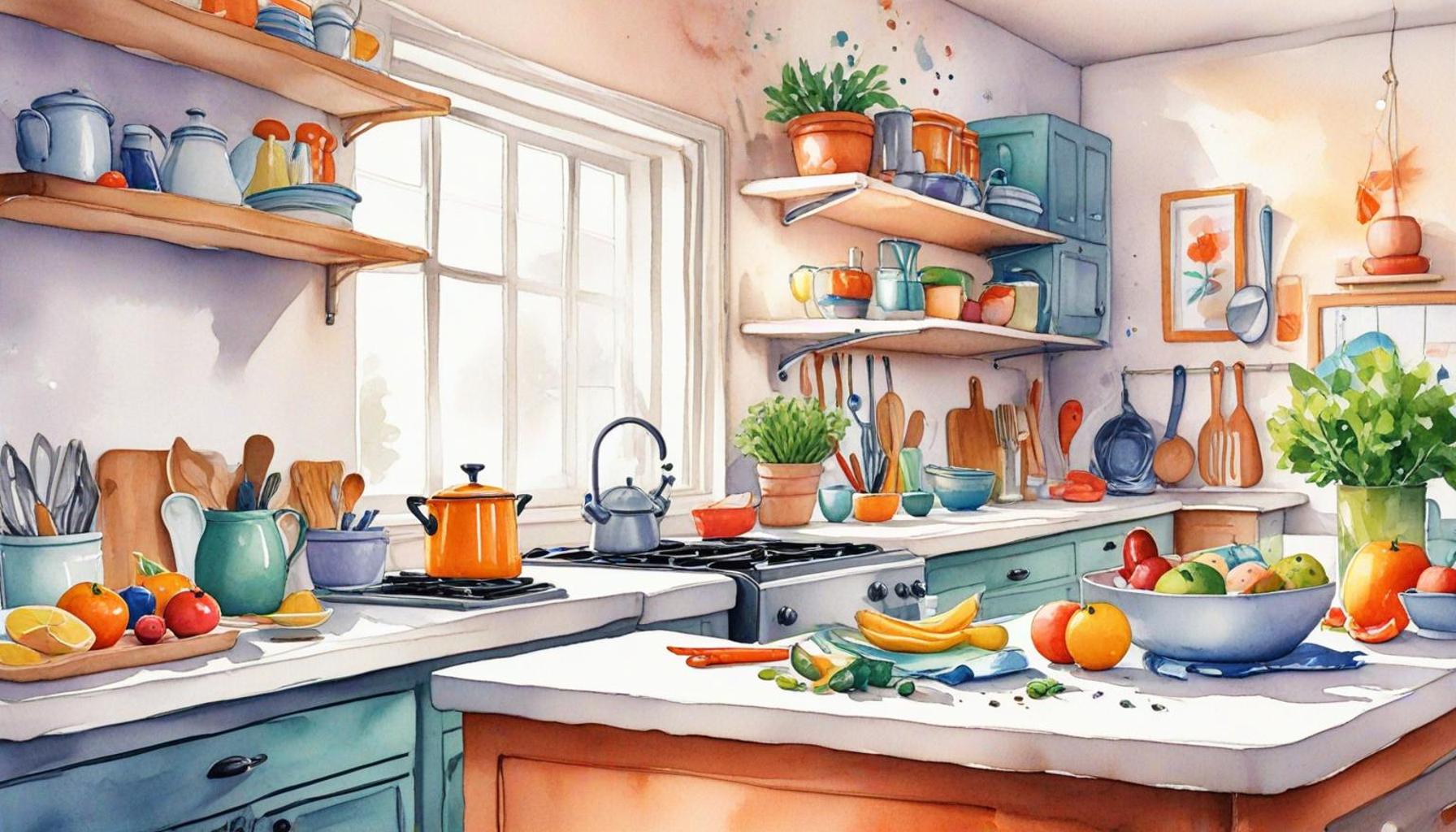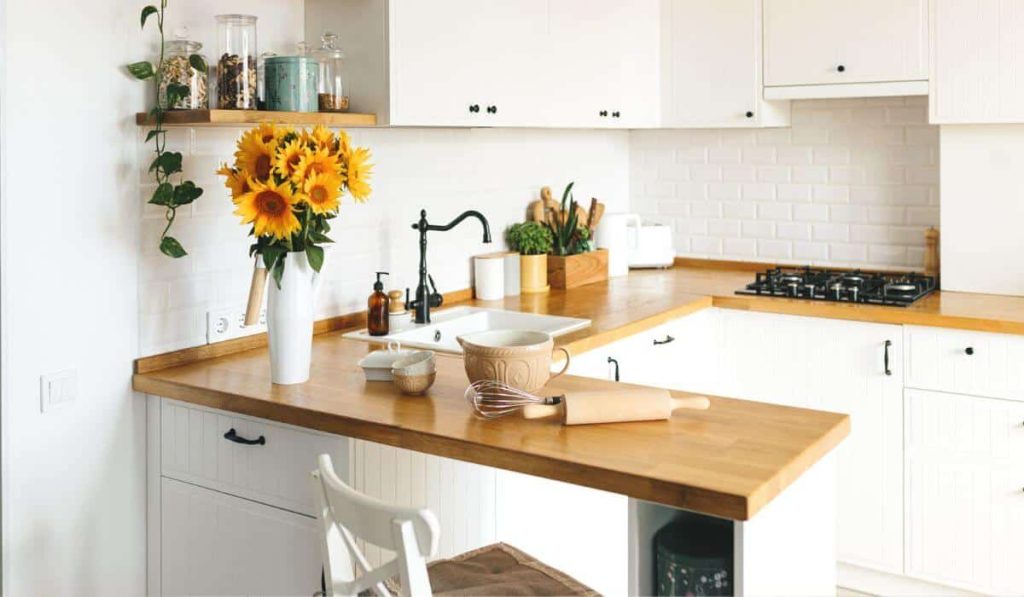Decluttering the Kitchen: Strategies to Simplify Your Space and Improve Your Eating Habits

Transform Your Kitchen for Better Living
A cluttered kitchen can hinder not only your cooking but also your overall well-being. In an age where health consciousness is on the rise, a streamlined kitchen can significantly impact your eating habits. The space where you create meals should inspire rather than overwhelm. A well-organized kitchen encourages cooking experimentation, promotes healthier food choices, and ultimately fosters a more enjoyable living experience.
Increased Efficiency
One of the most significant benefits of a decluttered kitchen is increased efficiency. A tidy area allows for quicker meal preparation and easier access to essential ingredients. For example, when you reach for a pan, it should be readily available instead of buried beneath stacks of disused cookware or kitchen gadgets. Prioritize your kitchen layout by adopting the “kitchen work triangle” principle, which connects the stove, sink, and refrigerator. This helps create a flow that reduces unnecessary movements, encouraging you to cook more frequently and effortlessly.
Healthier Choices
Healthier choices are often a direct result of an organized kitchen. When your pantry is well-organized and nutritious foods are at the forefront, you are more likely to opt for fruits and vegetables instead of hidden snacks that might be lurking behind clutter. Consider dedicating a specific shelf to healthy staples like whole grains, canned beans, and dried legumes. This not only makes these items more accessible but also serves as an ongoing reminder to nourish your body with wholesome food.
Less Stress
A tidy space can greatly reduce anxiety during cooking, encouraging you to experiment with new recipes. When your kitchen is disorganized, feelings of frustration can rise, making cooking feel like a chore rather than a creative outlet. Create a relaxing atmosphere by adding personal touches such as a small herb garden on the windowsill or a dedicated bulletin board for inspirational recipes. A calm environment can lead to new culinary adventures and foster a love for cooking.
Simple Decluttering Strategies
Implementing simple decluttering strategies can transform your kitchen experience. One effective method is to remove duplicate items or tools you rarely use. For instance, if you have three can openers and only one is functional, it’s time to let go of the excess. Focus on what truly enhances your cooking and encourages healthy eating. Start by categorizing items into essentials, frequently used, and seldom used, and then create designated spaces for each category.

Another practical tip is to identify hidden spaces—like the back of kitchen cabinets or the tops of appliances. Use these areas for storing items that you only use occasionally, freeing up prime real estate for everyday necessities. Additionally, consider investing in storage solutions like labeled bins or pull-out drawers to maximize organization.
This article will delve into actionable steps, such as how to categorize items, strategically utilize hidden spaces, and maintain organization over time. By streamlining your kitchen, you can create an environment conducive to a more mindful approach to eating. An organized kitchen not only enhances your cooking experience but also unlocks the full potential for healthier living in today’s fast-paced world.
DISCOVER MORE: Click here to transform your wardrobe</
Creating an Organized Space
In a busy household, the kitchen often becomes a catch-all for various items, turning an essential cooking space into a chaotic zone. To tackle this, the first step is creating an organized space where everything has a designated spot. By establishing clear categories for your kitchen items and tackling one section at a time, you can make the decluttering process manageable and even enjoyable.
Assessing Your Kitchen Inventory
Before diving into decluttering, conduct a thorough assessment of your kitchen inventory. Take an inventory of all your kitchen tools, cookware, and food items. This exercise helps you recognize the items you use regularly and the ones that just collect dust. Start by asking yourself these questions:
- How often do I use this item? If it hasn’t been used in the last year, consider donating or recycling it.
- Does this item serve a specific purpose? Multipurpose tools can save space while still being highly functional.
- Is the item in good condition? Broken items should be repaired or disposed of to avoid cluttering your kitchen.
As you evaluate your inventory, try to visualize the opportunities that lie within a streamlined kitchen. By prioritizing well-used and loved items, you can turn your attention to what truly enhances your cooking experience.
Creating Zones for Efficiency
A well-organized kitchen essentially functions like a well-oiled machine. Implementing zoning techniques can drastically improve your cooking efficiency. Consider the following kitchen zones:
- Prep Zone: This area should contain knives, cutting boards, and mixing bowls, allowing for seamless meal preparation.
- Cooking Zone: Store pots, pans, and utensils near the stove to facilitate cooking and reduce time spent searching for tools.
- Serving Zone: Keep platters, utensils, and dishware close to the dining area for efficient serving during meals.
By creating specific areas within your kitchen, you not only save time during meal prep but also foster a sense of order that enhances your cooking experience. Streamlining these zones encourages you to cook more often, ultimately leading to healthier eating habits.
Maintaining Your Kitchen’s New Look
Once you’ve embraced a decluttered kitchen, maintaining that newfound organization is crucial. Establish regular check-ins to ensure your kitchen remains an inspiring space. Set aside a few minutes each week to tidy up, remove any expired food items from the pantry, and ensure your kitchen tools are in their designated zones. This ongoing effort prevents clutter from accumulating again and keeps your kitchen aligned with your cooking and health goals.
As you embark on your journey of decluttering, remember that a simplified kitchen has the potential to transform not just your cooking habits but also your overall lifestyle. With an organized kitchen, you’ll find yourself more inclined to prepare meals at home, explore exciting recipes, and ultimately make more conscious decisions about what you eat.
| Advantage | Description |
|---|---|
| Increased Efficiency | A decluttered kitchen allows for quicker meal preparation, saving time during cooking and cleaning. |
| Enhanced Focus | Less visual chaos aids in concentrating on healthy meal choices, reducing the temptation of junk food. |
| Healthier Eating | Streamlined spaces promote the utilization of fresh ingredients, thereby fostering better eating habits. |
| Stress Reduction | A cleaner kitchen environment contributes to lower stress levels, making cooking a more enjoyable experience. |
In the pursuit of a simplified kitchen, one of the pivotal strategies includes utilizing organizational tools, such as drawer dividers and container sets, to maintain order. Another effective method is implementing the “one-in, one-out” rule, which emphasizes that for every new item brought into the kitchen, an existing one must be removed. This not only curtails excess but encourages mindful purchasing.Additionally, creating designated zones for different kitchen activities—such as cooking, baking, and food prep—can significantly enhance your workflow. Each zone can reflect its purpose, further contributing to a streamlined cooking process. By focusing on these strategies, not only can you declutter your space, but you can also pave the way for improved eating habits that promote long-term wellness and satisfaction in your culinary endeavors.
EXPLORE MORE: Click here to learn how simplicity can enhance your life
Streamlining Your Kitchen Gadgets
A significant part of decluttering the kitchen involves examining your gadget collection. Many home cooks quickly accumulate an extensive array of specialized kitchen tools that promise convenience but often lead to disorganization. Streamlining your kitchen gadgets can refresh your workspace and improve your cooking efficiency. The following strategies can help you evaluate your gadgetry:
- Limit Single-Use Items: While gadgets like avocado slicers or banana peelers seem innovative, ask yourself if they can serve their purposes with more versatile tools, such as knives or peelers. The less clutter you have, the easier it is to find what you need.
- Utilize Drawer Organizers: Invest in drawer dividers to keep utensils and small gadgets neatly arranged. This will save time and frustration as you search for that elusive can opener or potato masher.
- Evaluate Frequency of Use: If you haven’t reached for that food processor in over a year, consider whether it’s time to donate it. Stick to versatile tools that you’ll use regularly, leaving your drawers and cabinets less cramped.
By consolidating your gadgets, you are not only reducing clutter but increasing your ability to cook efficiently and creatively.
Revamping Your Pantry
The pantry plays a crucial role in your eating habits, as it stores essential ingredients for meal preparation. To maintain a decluttered kitchen, revamping your pantry should be a priority. A well-organized pantry not only looks aesthetically pleasing but encourages healthier snacking and meal choices. Start by following these steps:
- Clear Out Expired Items: Regularly check for expired goods, especially those lurking in the back of your pantry. Removing these not only clears space but also ensures you aren’t consuming unhealthy items.
- Group Similar Items: Keep grains together, cereals stacked neatly in bins, and canned goods categorized. This will make it easier to find what you need quickly.
- Use Clear Containers: Consider transferring dry goods into clear, labeled containers. Not only do these keep items fresh, but they also visually communicate what you have at a glance, reducing the likelihood of buying duplicates.
An organized pantry is linearly linked to improved eating habits; when you see healthy ingredients readily available, you’re more likely to choose them over processed snacks.
Incorporating Mindful Eating Practices
Decluttering your kitchen space can directly influence your eating habits, particularly when combined with mindful eating practices. Having an organized kitchen reduces overwhelming choices and manipulates your environment to promote healthier decisions. Here are some tips for applying mindfulness in your kitchen routine:
- Plan Your Meals: Dedicate time each week for meal planning. When meals are pre-decided, you cultivate a more intentional approach to eating, minimizing impulsive, unhealthy snacking.
- Prep Ingredients Ahead: Organize a weekend prepping session where you wash and chop vegetables or portion out snacks. Having these items ready to go encourages you to opt for healthier choices during the week.
- Mind Your Portions: Use smaller plates and bowls when serving meals. Visually, this can make portion sizes appear larger and help in reducing overeating.
The combination of redefining your kitchen space with a focus on practicality and retrieval leads to an atmosphere where you’ll feel more inspired to experiment with new, healthy recipes. As your cooking practices evolve, so too will your culinary adventures and family meals. By focusing on building a sustainable culinary environment through decluttering, you’ll be equipping yourself to foster a healthier lifestyle.
DISCOVER MORE: Click here to transform your wardrobe</
Conclusion
In the journey towards a healthier lifestyle, decluttering your kitchen is not just about creating a visually appealing space; it’s a transformative strategy that directly impacts your eating habits and culinary creativity. By taking the time to streamline your kitchen gadgets, revamp your pantry, and incorporate mindful eating practices, you establish an environment that promotes efficiency and healthier choices.
As you limit single-use gadgets, organize your pantry, and plan meals intentionally, you set the stage for a cooking experience that is not only enjoyable but also encourages you to choose nourishing ingredients over processed options. The simple act of clearing out expired items, grouping similar foods, and utilizing clear containers not only alleviates chaos but also lays the groundwork for more conscious eating decisions.
This intentional approach fosters a deeper connection with the food you prepare and consume, empowering you to explore a wider range of ingredients and recipes. In essence, a decluttered kitchen acts as a canvas for your culinary creativity, allowing you to embark on a more fulfilling food journey. As you simplify your space, reflect on the profound impact this can have on your health and lifestyle.
Now is the time to take action—embrace these practical strategies and watch as your kitchen transforms into a hub of inspiration and well-being. By prioritizing a well-organized kitchen, you are investing in your health and cultivating lifelong positive eating habits that can benefit you and your family.


